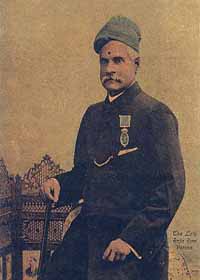Raja Ravi Verma
BORN DIED EDUCATION QUALIFICATIONS SELECTED POSTHUMOUS EXHIBITIONS SELECTED EXHIBITIONS HONORS AND AWARD ABOUT THE ARTIST Raja Ravi Varma Indian Malayali painter. He is considered one of the most important painters in the history of Indian art. Firstly, he the best examples of European techniques with a purely Indian sensibility. His works are considered among While they continue the tradition and aesthetics of Indian art, his paintings employed the latest European academic artistic techniques of the time. Secondly, he was notable for making affordable lithographs of his paintings available to the public, which greatly enhanced his reach and influence as a painter and public figure. His lithographs increased common people's participation in the fine arts and defined artistic tastes among common people for several decades. In particular, his depictions of Hindu deities and episodes from the epics and Puranas have received deep acceptance by the public and are found, often as objects of worship, throughout India. Raja Ravi Varma was closely related to the Travancore royal family of the present-day state of Kerala in India. The art of Raja Ravi Varma marks a historic turn in the development of modern art and Indian artists, at the beginning of the Indian independence movement. Ravi Varma's works, which incorporated the use of oil as a medium and a distinctly European style of realism, influenced other artists and shaped a new perception of Indian art. All this took place at a time in Indian history when the call of the day was a modern and progressive India. Born in Kilimanoor, Kerala, in 1848 to a princely family, Ravi Varma was educated as a court artist in Trivandrum. During the 1860s he continued to study and work in Travancore, where other court painters, such as Ramaswamy Naicker of the Tanjore School, first adopted oil as a medium. In 1866, Ravi Varma married the sister of Maharani Lakshmibai of the Travancore royal family and was allowed to use the title Koil Tampuran, since he was not a full Raja, which he has inscribed in some of his works. (source Maharaja Fatesingh Museum Trust, Dr. Ratan Parimoo) Only a couple of years later, his influences arose from the opportunity to observe the European portrait painter Theodore Jensen at work, which presumably prompted Ravi Varma to develop his style. This unique style incorporated European naturalism and realism, with distinctly Indian mythological themes. The distinguishing factor, however, was Ravi Varma's depiction of mythological figures in a natural human style rather than the traditional supernatural imagery used to convey gods, goddesses, and their myths or tales. Ravi Varma's innovative work lies not only in his art style but also in his influence on other artists and collectors. During the 1870s and 1880s, he had several commissioned portraits, participated in exhibitions, and received several awards. However, it was after Maharaja Sayajirao Gaekwad invited Ravi Varma to Baroda and became his most important patron, that Ravi Varma gained eminence. His work included portraits of members of Indian royal families, foreign dignitaries, and British colonial officials. During this time, he was assisted by his brother, Raja Raja Varma, who dedicated his life to working with Ravi Varma. Raja Ravi Varma's work documents historical relationships and events, largely through simple portraits. In 1892, Ravi Varma started his printing press in Bombay, where he made color reproductions of his work and expanded his reach. This allowed him to become one of the most prolific artists of his time. In 1904, Viceroy Lord Curzon, on behalf of the British King-Emperor, awarded Varma the Kaisar-i-Hind gold medal. A university dedicated to fine arts was also established in his honor in Mavelikara, Kerala. Raja Ravi Varma High School in Kilimanoor is named after him and there are many cultural organizations across India named after him. In 2013, Mercury's Varma crater was named in his honor. Considering his enormous contribution to Indian art, the Government of Kerala has instituted an award called Raja Ravi Varma Puraskaram, which is given every year to people who demonstrate excellence in the field of art and culture. Raja Ravi Varma has held many important exhibitions, both in India and internationally. However, the first was in Madras, where he presented a Nair woman with a jasmine flower in her hair and won the Governor's Gold Medal. From there he went on to paint for various royal families from India and colonial and royal visitors from England. Raja Ravi Varma died at Kilimanoor, his birthplace, on 2 October 1906. Notification - We do not usually display Raja Ravi Verma's work, only send it to private art collectors and interested art buyers.
April 29, 1848, Kilimanoor, Travancore, Kerala
October 2, 1906 Kilimanoor
1868 Learned the technique of oil painting from European painter Theodore Jensen and Alagiri Naidu, court painter of Swati Tirana, Maharaja of Travancore.
1862 Self-taught and receives his first painting lessons from his uncle Raja Raja Varma.
2011 Ethos V Indian Art through the Lens of History (1900 to 1980), Indigo Blue Art, Singapore
2011 Manifestations VI, Delhi Art Gallery, New Delhi
2003 Demonstrations, Delhi Art Gallery, New Delhi and World Trade Centre, Mumbai
1993 Exhibition of paintings, drawings, and oleographs at Sri Chitra Art Gallery, Trivandrum, National Gallery of Modern Art (NGMA), National Museum, New Delhi.
1903 Lalit Kala Sangam, Chennai
1899 Baroda Puranic Commission Exhibition, Baroda and Mumbai
1893 World Colombian Exposition, Chicago
1889 Inaugural Exhibition, Bombay Art Society, Mumbai
Exhibition of 1880 in Poona
1873-74, 76 Society of Fine Arts, Chennai
Vienna Exhibition of 1873, Austria
1880 Gaekwad Gold Medal, Poona
1873, 74, 76 Governor's Gold Medal, Exhibition of the Society of Fine Arts, Chennai
Vienna Exhibition of 1873
Barman Arts Online


